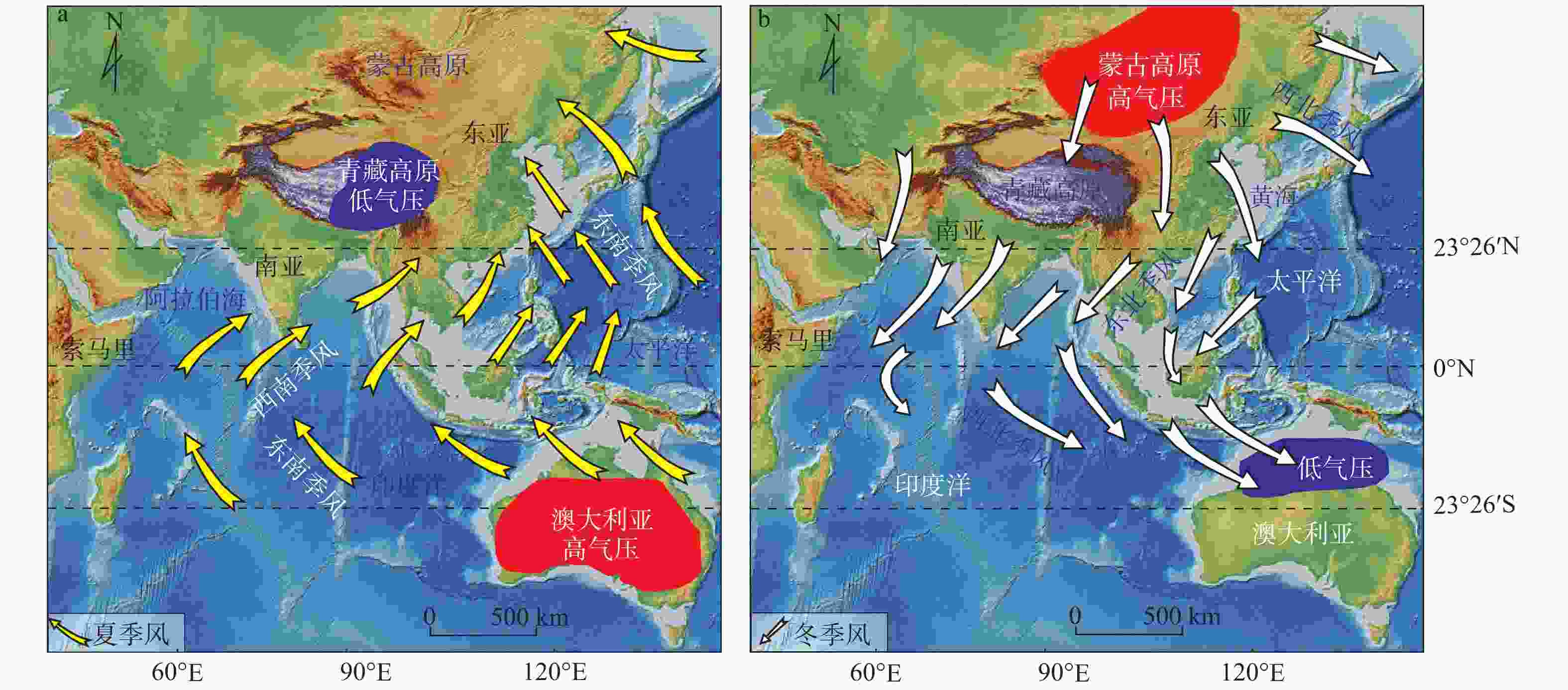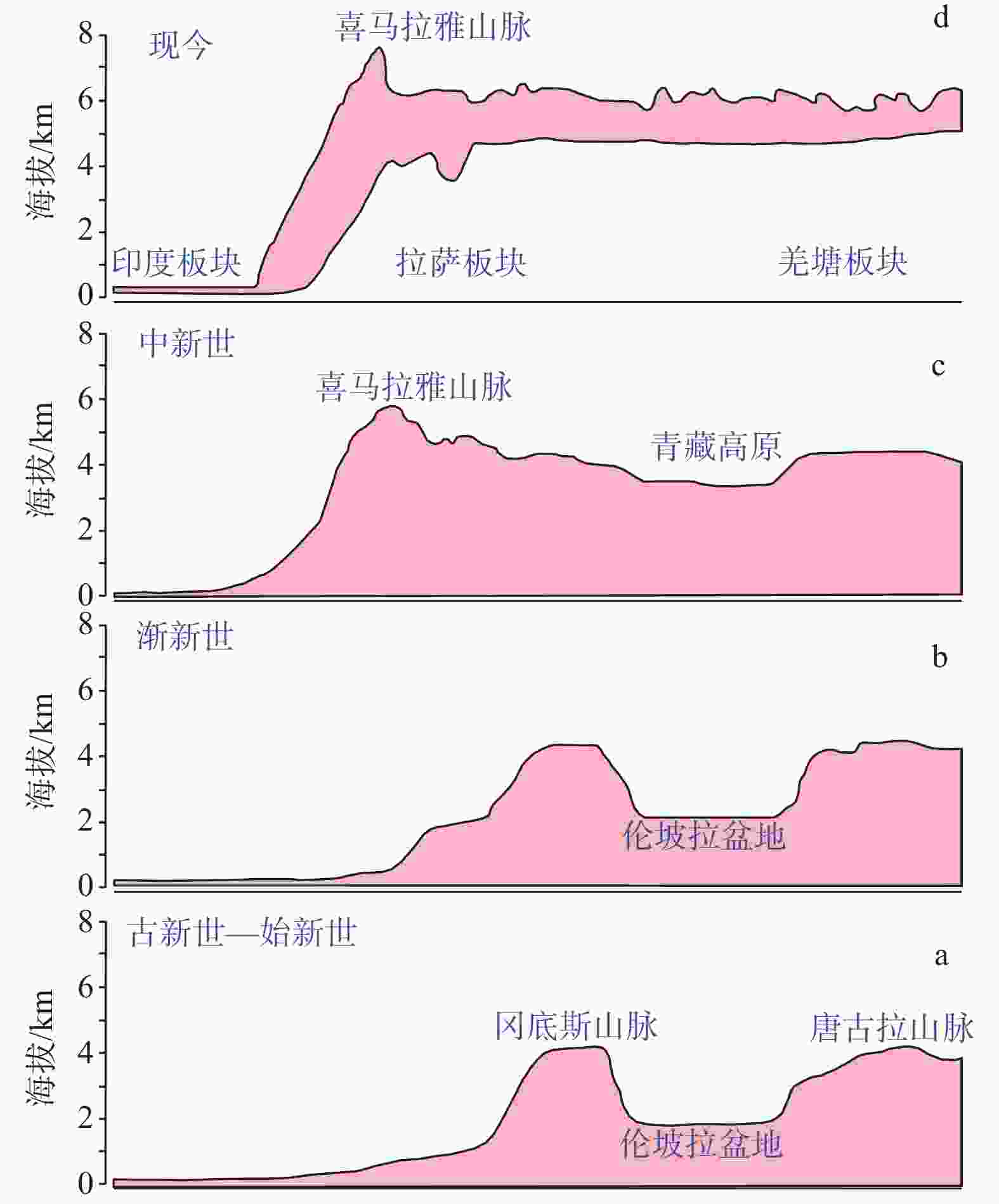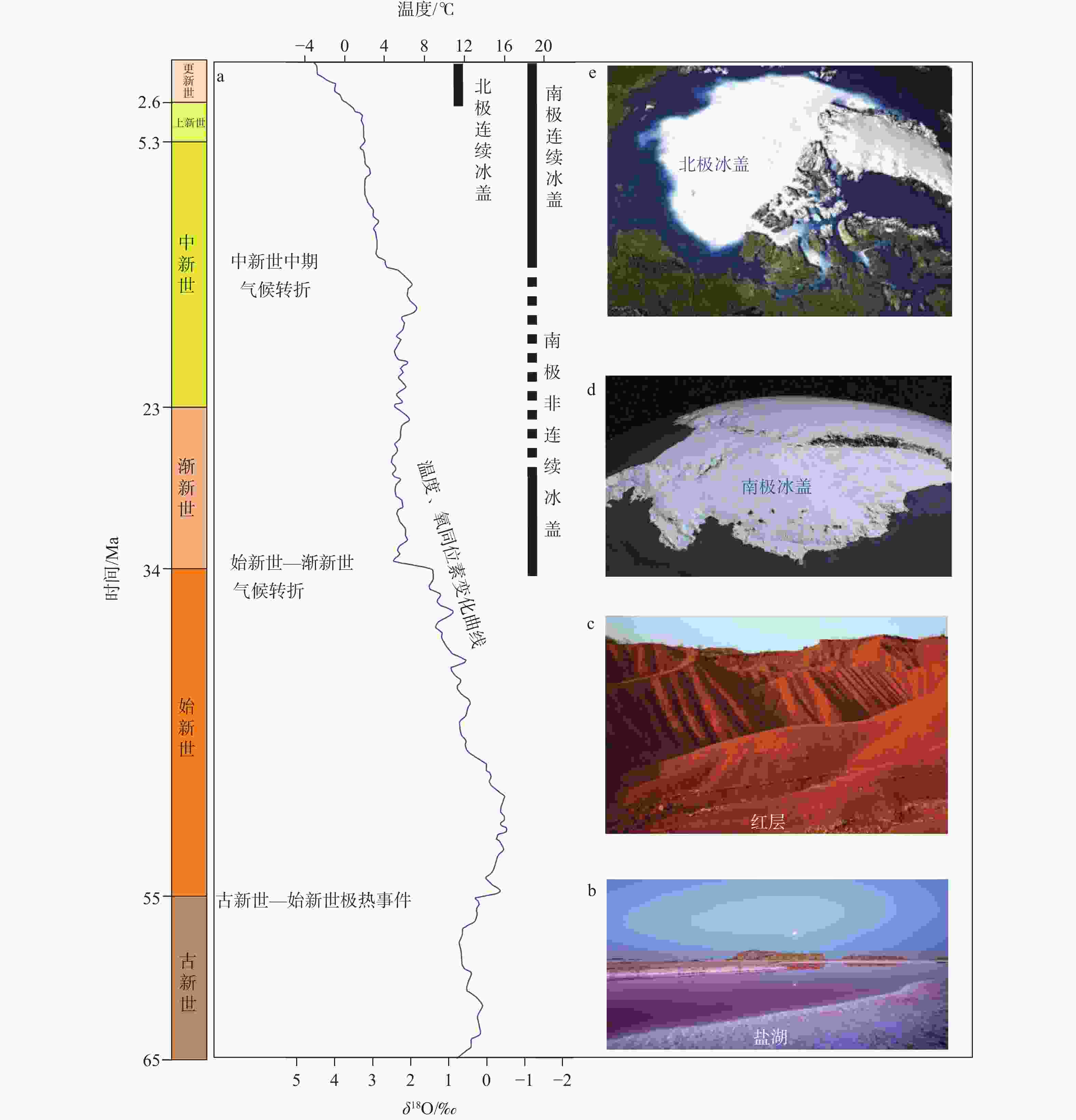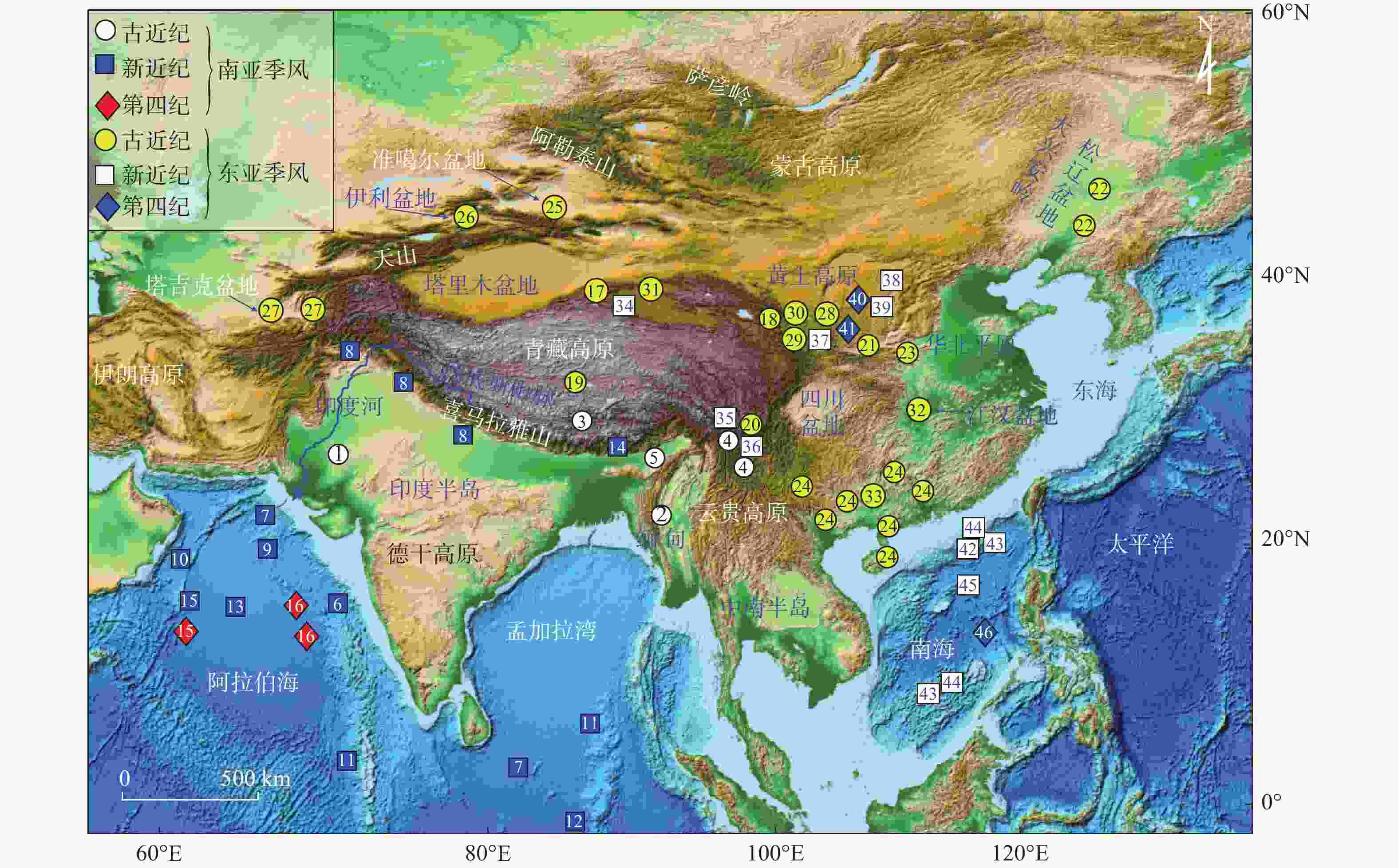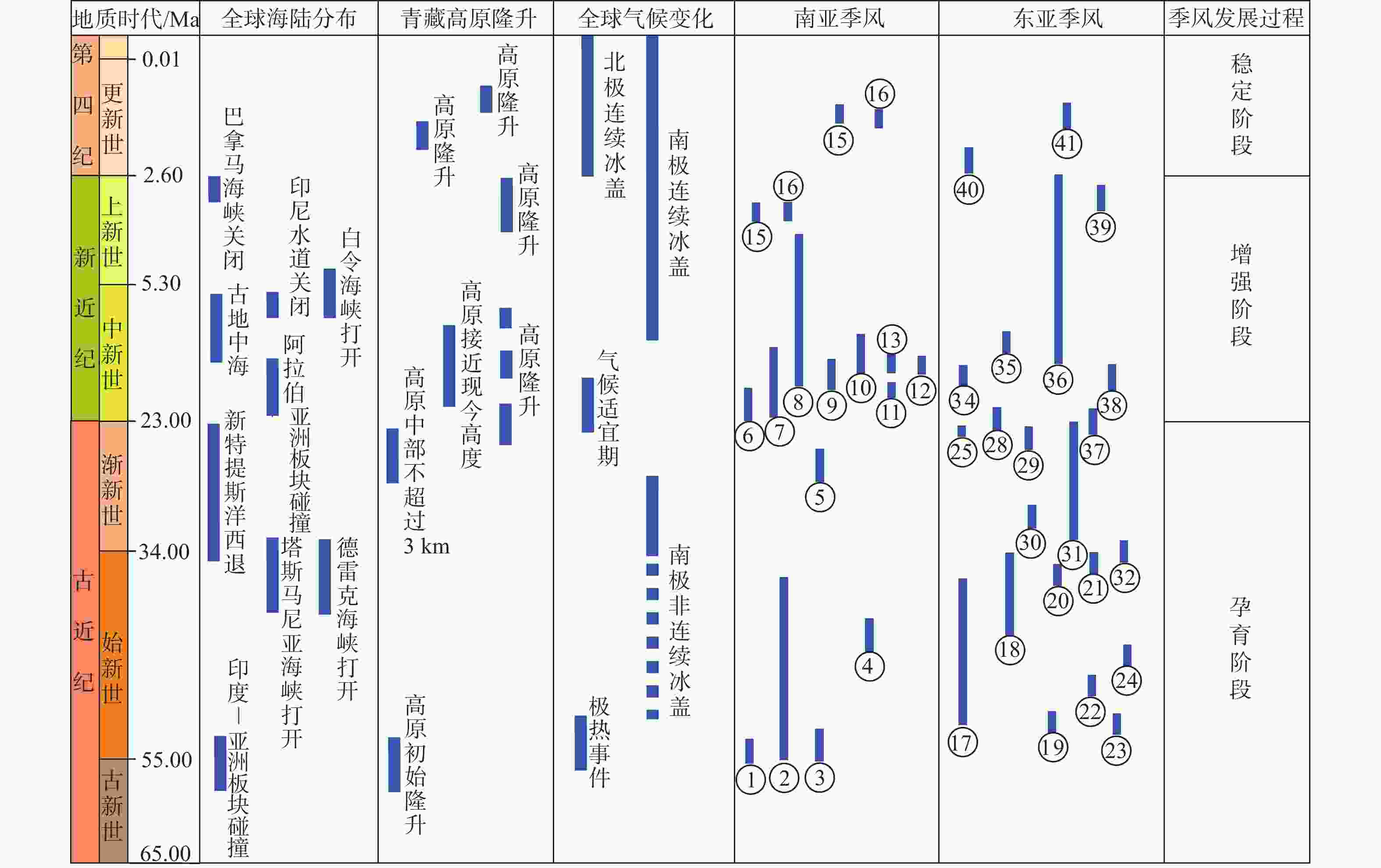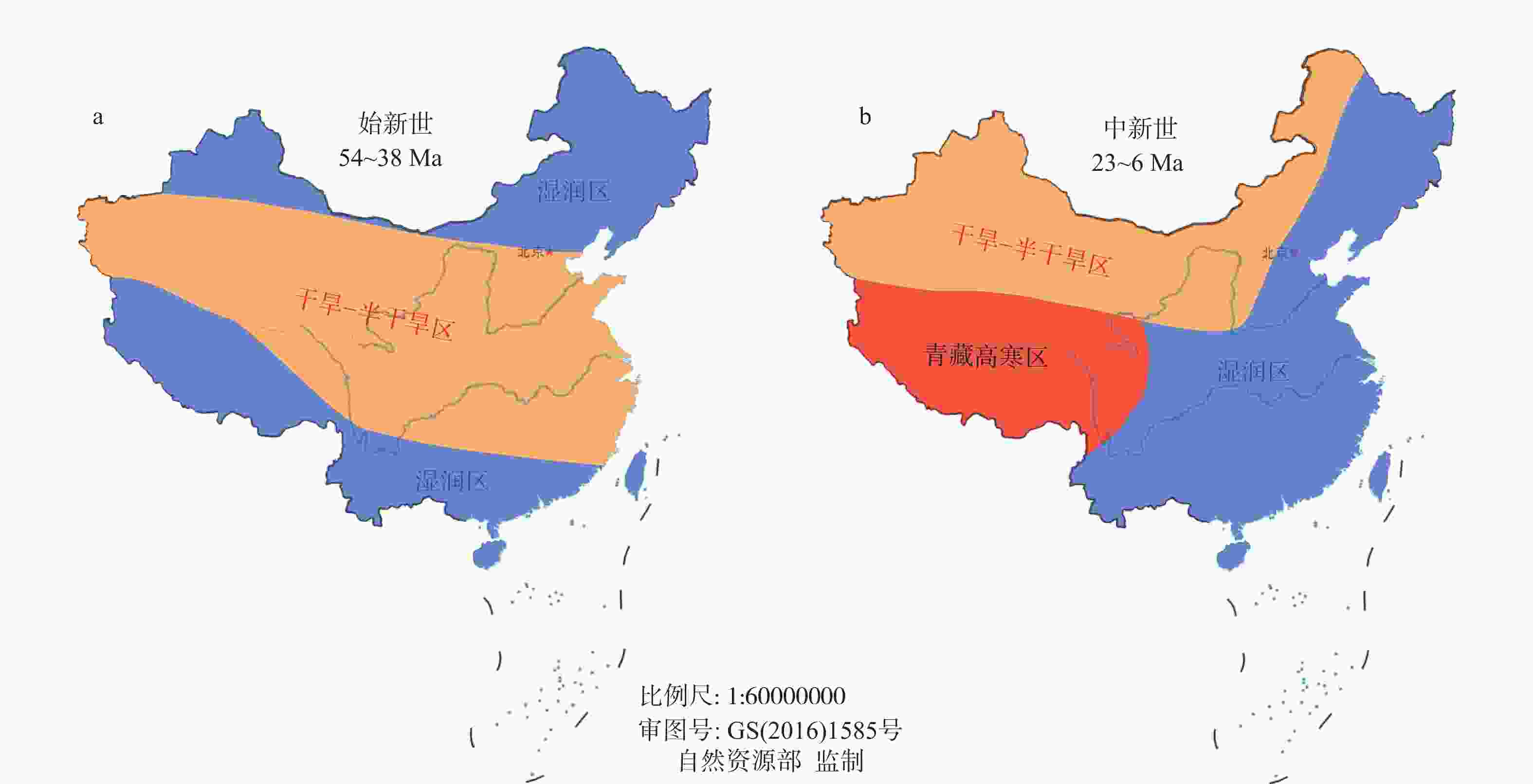The evolutionary process of Cenozoic Asian monsoon
-
摘要: 陆地和海洋热容量差异会引起风向和降水发生季节性反转形成季风气候。亚洲是世界上季风气候最典型的区域,同时也有最多的受季风气候影响的人口。季风带来的强降水容易诱发多种次生灾害,严重影响着区域内人类社会生产、居住的安全,因而认识亚洲季风的形成过程至关重要。利用将古论今的地学思想,文章旨在阐述亚洲季风的组成,列举影响亚洲季风形成、演化的主要因素,总结亚洲关键地点的沉积记录显示的南亚季风和东亚季风的演化期次。结果表明,在古近纪,印度板块与亚洲大陆南缘发生碰撞,改变了亚洲的海陆分布,导致青藏高原发生初始隆升,南亚和东亚均出现季风性气候。但此时的东亚地区依然主要受行星风系的控制,东亚季风处于孕育阶段,仅呈条带状局部分布在华南板块的南缘,而南亚季风的覆盖面积相对广泛。这可能主要是因为东亚地区的边缘海打开时间明显要晚于南亚地区海陆分布出现的时间。但随着青藏高原在中新世整体隆升并接近现今的海拔高度,亚洲季风全面进入增强阶段,强烈影响区域内的地质演化过程。自中新世中期以来,由于受控于青藏高原隆升、南北极冰盖的发育,亚洲季风经历了多期次的稳定发展阶段。研究成果为科学合理利用季风开展亚洲系统地球科学研究提供了参考。Abstract:
Objective The formation of monsoon climates is attributed to the seasonal reversal of wind direction and precipitation caused by the difference in thermal capacity between land and ocean. Asia is recognized as the most prominent region globally, with monsoon climates, that affect the largest population. The heavy rainfall accompanying monsoons can result in various secondary disasters, substatially jeopardizing human safety and productivity in the region. Consequently, comprehending the formation process of the Asian monsoon holds paramount importance. Methods This study aim to employ geological concepts to establish a connection between the past and present, providing an overview of the components of Asian monsoons, identifying the primary factors influencing their formation and evolution, and summarizing research progress on the South Asian and East Asian monsoons based on sediment records from key Asian locations. Results The findings indicate that during the Cenozoic, the collision between the Indian Plate and the southern margin of the Asian continent altered the distribution of land and sea in Asia. Consequently, the Tibetan Plateau experienced initial uplift, contributing to the emergence of monsoon climates in South Asia and East Asia. However, at this stage, the East Asian region was still primarily influenced by the planetary wind system, and the East Asian monsoon was in its early stages, predominantly restricted to the southern margin of the South China Plate in a localized manner. In contrast, the South Asian Monsoon covered a relatively extensive area. This discrepancy may be attributed to the delayed opening of marginal seas in the East Asian region compared to the relatively earlier occurrence of land and sea distribution in South Asia. However, as the Tibetan Plateau continued to uplift and approach its current altitude during the middle to late Cenozoic, the Asian monsoon entered a strengthening phase, notably impacting regional geological evolution processes. Since the middle to late Cenozoic, the development of the North and South Polar ice caps and the upliftment of the Tibetan Plateau have controlled the Asian monsoon, leading it to undergo multiple stable periods of development. Conclusion The development and evolution of the East Asian and South Asian monsoons are mainly driven by the distribution of sea and land in the Asia, the upliftment of the Tibetan Plateau and the global climate change during the Cenozoic. Significance These findings provide valuable insights into the scientific and rational utilization of the Asian monsoon for conducting systematic Earth science research in Asia. -
Key words:
- Asian Monsoon /
- East Asian Monsoon /
- Tibetan Plateau /
- South Asian Monsoon /
- Cenozoic
-
图 1 亚洲季风组成分布图(据林旭等,2023修改)
Figure 1. Composition distribution map of Asian monsoon (modified after Lin et al., 2023)
图 4 新生代青藏高原演化过程图(据Su et al.,2019修改)
a—古新世—始新世;b—渐新世;c—中新世;d—现今
Figure 4. Cenozoic evolutionary process diagram of the Tibetan Plateau (modified after Su et al.,2019)
(a) Paleocene-Eocene; (b) Oligocene; (c) Miocene ; (d) Present day
图 5 新生代气候变化特征
a—新生代全球深海氧同位素曲线(据Zachos et al.,2001修改);b—古新世干旱气候下形成的盐湖;c—始新世干燥气候形成的红层;d—中新世连续性南极冰盖出现;e—上新世晚期—更新世连续性北极冰盖出现
Figure 5. Characteristics of Cenozoic climate change
(a) Cenozoic global deep-sea oxygen isotope curve (modified after Zachos et al.,2001); (b) Salt lakes formed in the arid climate of the Paleocene; (c) The red layer formed in the dry climate of the Eocene; (d) The emergence of a continuous Antarctic ice sheet during the Miocene; (e) The late Pliocene-Pleistocene continuous Arctic ice sheet appeared
图 6 亚洲季风研究结果位置分布图
①Shukla et al.(2014),Bhatia et al.(2021);②Licht et al.(2014),Huang et al.(2023);③Ding et al.(2017);④Fang et al.(2021);⑤Srivastava et al.(2012);⑥Beasley et al.(2021);⑦Clift et al.(2008);⑧Sanyal and Sinha(2010);⑨Clift et al.(2002);⑩Gupta et al.(2015);⑪Betzler et al.(2016),Bretschneider et al.(2021);⑫Gupta et al.(2004);⑬Tripathi et al.(2017);⑭Khan et al.(2019);⑮Cai et al.(2020);⑯Lu et al.(2020);⑰Li et al.(2018a);⑱Dupont-Nivet et al.(2007),Licht et al.(2014);⑲Su et al.(2020);⑳Sorrel et al.(2017),Zheng et al.(2022),Yuan et al.(2024);㉑Lyu et al.(2021);㉒Quan et al.(2011),Meng et al.(2018a);㉓Su et al.(2022);㉔Xie et al.(2020b);㉕Sun et al.(2010);㉖Hellwig et al.(2018);㉗Wang et al.(2020);㉘Lin et al.(2015);㉙Wu et al.(2017);㉚Miao et al.(2013);㉛Yan et al.(2018);㉜Huang and Hinnov(2019);㉝Ren et al.(2021),Vornlocher et al.(2021);㉞Miao et al.(2011);㉟Jacques et al.(2011);㊱Li et al.(2019);㊲Guo et al.(2002);㊳An et al.(2001);㊴Ao et al.(2016);㊵Meng et al.(2018b);㊶Song et al.(2013);㊷Jia et al.(2003),Ding et al.(2021);㊸Wan et al.(2007);㊹Chen et al.(2003),Holbourn et al.(2021);㊺Wang et al.(2003b),Zheng et al.(2004);㊻Wang et al.(2003b);Gai et al.(2020)
Figure 6. Location distribution of research results of the Asian monsoon
图 7 新生代南亚和东亚季风演化过程与全球海陆分布、青藏高原隆升和全球气候变化的对应关系(图中数字与图6的位置一一对应,蓝色矩形框的长度代表时间跨度)
Figure 7. Correspondence between the evolution of the Cenozoic South Asian and East Asian monsoons and the global land-sea distribution, the uplift of the Tibetan Plateau, and global climate change (The numbers in the figure correspond to the positions in Figure 6; the length of the blue rectangular box represents the time)
图 8 新生代东亚气候演变过程图(据Guo et al.,2008修改)
a—始新世气候格局分布图;b—中新世气候格局分布图
Figure 8. Climate evolution in East Asia during the Cenozoic era (modified after Guo et al., 2008)
(a) Eocene climate pattern distribution map; (b) Miocene climate pattern distribution map
-
[1] ALEKSEEV M N, DROUCHITS V A, 2004. Quaternary fluvial sediments in the Russian arctic and subarctic: late Cenozoic development of the Lena River system, northeastern Siberia[J]. Proceedings of the Geologists' Association, 115(4): 339-346. doi: 10.1016/S0016-7878(04)80013-0 [2] AN Z S, KUTZBACH J E, PRELL W L, et al., 2001. Evolution of Asian monsoons and phased uplift of the Himalaya–Tibetan Plateau since Late Miocene times[J]. Nature, 411(6833): 62-66. doi: 10.1038/35075035 [3] AN Z S, 2014. Late Cenozoic climate change in Asia: loess, monsoon and monsoon-arid environment evolution[M]. Dordrecht: Springer. [4] AN Z S, WU G X, LI J P, et al., 2015. Global monsoon dynamics and climate change[J]. Journal of Earth Environment, 6(6): 341-381. (in Chinese with English abstract [5] AO H, ROBERTS A P, DEKKERS M J, et al., 2016. Late Miocene–Pliocene Asian monsoon intensification linked to Antarctic ice-sheet growth[J]. Earth and Planetary Science Letters, 444: 75-87. doi: 10.1016/j.jpgl.2016.03.028 [6] BAHR A, KABOTH-BAHR S, KARAS C, 2023. The opening and closure of oceanic seaways during the Cenozoic: pacemaker of global climate change?[J]. Geological Society, London, Special Publications, 523(1): SP523-2021-54. [7] BARBOLINI N, WOUTERSEN A, DUPONT-NIVET G, et al., 2020. Cenozoic evolution of the steppe-desert biome in Central Asia[J]. Science Advances, 6(41): eabb8227. doi: 10.1126/sciadv.abb8227 [8] BEASLEY C, KENDER S, GIOSAN L, et al., 2021. Evidence of a South Asian proto-monsoon during the Oligocene-Miocene transition[J]. Paleoceanography and Paleoclimatology, 36(9): e2021PA004278. doi: 10.1029/2021PA004278 [9] BETZLER C, EBERLI G P, KROON D, et al., 2016. The abrupt onset of the modern South Asian Monsoon winds[J]. Scientific Reports, 6(1): 29838. doi: 10.1038/srep29838 [10] BHATIA H, KHAN M A, SRIVASTAVA G, et al., 2021. Late Cretaceous–Paleogene Indian monsoon climate vis-à-vis movement of the Indian plate, and the birth of the South Asian Monsoon[J]. Gondwana Research, 93: 89-100. doi: 10.1016/j.gr.2021.01.010 [11] BRETSCHNEIDER L, HATHORNE E C, HUANG H, et al., 2021. Provenance and weathering of clays delivered to the Bay of Bengal during the middle Miocene: Linkages to tectonics and monsoonal climate[J]. Paleoceanography and Paleoclimatology, 36(2): e2020PA003917. doi: 10.1029/2020PA003917 [12] CAI M J, XU Z K, CLIFT P D, et al., 2020. Long-term history of sediment inputs to the eastern Arabian Sea and its implications for the evolution of the Indian summer monsoon since 3.7 Ma[J]. Geological Magazine, 157(6): 908-919. doi: 10.1017/S0016756818000857 [13] CANE M A, MOLNAR P, 2001. Closing of the Indonesian seaway as a precursor to east African aridification around 3-4 million years ago[J]. Nature, 411(6834): 157-162. doi: 10.1038/35075500 [14] CHEN J L, HUANG R H, 2006. The comparison of climatological characteristics among Asian and Australian monsoon subsystems. Part I. The wind structure of summer monsoon[J]. Chinese Journal of Atmospheric Sciences, 30(6): 1091-1102. (in Chinese with English abstract [15] CHEN M H, WANG R J, YANG L H, et al., 2003. Development of East Asian summer monsoon environments in the late Miocene: radiolarian evidence from site 1143 of ODP Leg 184[J]. Marine Geology, 201(1-3): 169-177. doi: 10.1016/S0025-3227(03)00215-9 [16] CHUNG S L, LO C H, LEE T Y, et al., 1998. Diachronous uplift of the Tibetan plateau starting 40 Myr ago[J]. Nature, 394(6695): 769-773. doi: 10.1038/29511 [17] CLIFT P, GAEDICKE C, EDWARDS R, et al., 2002. The stratigraphic evolution of the Indus Fan and the history of sedimentation in the Arabian Sea[J]. Marine Geophysical Researches, 23(3): 223-245. doi: 10.1023/A:1023627123093 [18] CLIFT P D, LAYNE G D, BLUSZTAJN J, 2004. Marine sedimentary evidence for monsoon strengthening, Tibetan uplift and drainage evolution in East Asia[M]//CLIFT P, KUHNT W, WANG P, et al. Continent-ocean interactions within East Asian marginal seas. Washington DC, USA. American Geophysical Union: 255-282. [19] CLIFT P D, PLUMB R A, 2008. The Asian monsoon: causes, history and effects[M]. Cambridge: Cambridge University Press. [20] CLIFT P D, HODGES K V, HESLOP D, et al., 2008. Correlation of Himalayan exhumation rates and Asian monsoon intensity[J]. Nature Geoscience, 1(12): 875-880. doi: 10.1038/ngeo351 [21] CLOTTEN C, STEIN R, FAHL K, et al., 2019. On the causes of Arctic sea ice in the warm Early Pliocene[J]. Scientific Reports, 9(1): 989. doi: 10.1038/s41598-018-37047-y [22] DENG T, WANG X M, WU F X, et al., 2019. Review: implications of vertebrate fossils for paleo-elevations of the Tibetan Plateau[J]. Global and Planetary Change, 174: 58-69. doi: 10.1016/j.gloplacha.2019.01.005 [23] DING L, SPICER R A, YANG J, et al., 2017. Quantifying the rise of the Himalaya orogen and implications for the South Asian monsoon[J]. Geology, 45(3): 215-218. doi: 10.1130/G38583.1 [24] DING L, KAPP P, CAI F L, et al., 2022. Timing and mechanisms of Tibetan Plateau uplift[J]. Nature Reviews Earth & Environment, 3(10): 652-667. [25] DING W J, HOU D J, GAN J, et al., 2021. Palaeovegetation variation in response to the late Oligocene-early Miocene East Asian summer monsoon in the Ying-Qiong Basin, South China Sea[J]. Palaeogeography, Palaeoclimatology, Palaeoecology, 567: 110205. doi: 10.1016/j.palaeo.2020.110205 [26] DING Y H, CHAN J C L, 2005. The East Asian summer monsoon: an overview[J]. Meteorology and Atmospheric Physics, 89(1-4): 117-142. doi: 10.1007/s00703-005-0125-z [27] DING Y H, SUN Y, LIU Y Y, et al., 2013. Interdecadal and interannual variabilities of the Asian summer monsoon and its projection of future change[J]. Chinese Journal of Atmospheric Sciences, 37(2): 253-280. (in Chinese with English abstract [28] DUK-RODKIN A, BARENDREGT R W, FROESE D G, et al., 2004. Timing and extent of Plio-Pleistocene glaciations in north-western Canada and east-central Alaska[J]. Developments in Quaternary Sciences, 2: 313-345. [29] DUPONT-NIVET G, KRIJGSMAN W, LANGEREIS C G, et al., 2007. Tibetan plateau aridification linked to global cooling at the Eocene–Oligocene transition[J]. Nature, 445(7128): 635-638. doi: 10.1038/nature05516 [30] EHRMANN W U, MACKENSEN A, 1992. Sedimentological evidence for the formation of an East Antarctic ice sheet in Eocene/Oligocene time[J]. Palaeogeography, Palaeoclimatology, Palaeoecology, 93(1-2): 85-112. doi: 10.1016/0031-0182(92)90185-8 [31] FANG X M, YAN M D, ZHANG W L, et al., 2021. Paleogeography control of Indian monsoon intensification and expansion at 41 Ma[J]. Science Bulletin, 66(22): 2320-2328. doi: 10.1016/j.scib.2021.07.023 [32] FANG X M, GUO Z T, JIANG D B, et al., 2022. No monsoon-dominated climate in northern subtropical Asia before 35 Ma[J]. Global and Planetary Change, 218: 103970. doi: 10.1016/j.gloplacha.2022.103970 [33] FLUTEAU F, RAMSTEIN G, BESSE J, 1999. Simulating the evolution of the Asian and African monsoons during the past 30 Myr using an atmospheric general circulation model[J]. Journal of Geophysical Research: Atmospheres, 104(D10): 11995-12018. doi: 10.1029/1999JD900048 [34] GAI C C, LIU Q S, ROBERTS A P, et al., 2020. East Asian monsoon evolution since the late Miocene from the South China Sea[J]. Earth and Planetary Science Letters, 530: 115960. doi: 10.1016/j.jpgl.2019.115960 [35] GALLAGHER S J, WALLACE M W, LI C L, et al., 2009. Neogene history of the West Pacific warm pool, Kuroshio and Leeuwin currents[J]. Paleoceanography, 24(1): PA1206. [36] GLADENKOV A Y, OLEINIK A E, MARINCOVICH JR L, et al., 2002. A refined age for the earliest opening of Bering Strait[J]. Palaeogeography, Palaeoclimatology, Palaeoecology, 183(3-4): 321-328. doi: 10.1016/S0031-0182(02)00249-3 [37] GUO Z T, RUDDIMAN W F, HAO Q Z, et al., 2002. Onset of Asian desertification by 22 Myr ago inferred from loess deposits in China[J]. Nature, 416(6877): 159-163. doi: 10.1038/416159a [38] GUO Z T, SUN B, ZHANG Z S, et al., 2008. A major reorganization of Asian climate by the early Miocene[J]. Climate of the Past, 4(3): 153-174. doi: 10.5194/cp-4-153-2008 [39] GUPTA A K, SINGH R K, JOSEPH S, et al., 2004. Indian Ocean high-productivity event (10-8 Ma): Linked to global cooling or to the initiation of the Indian monsoons?[J]. Geology, 32(9): 753-756. doi: 10.1130/G20662.1 [40] GUPTA A K, YUVARAJA A, PRAKASAM M, et al., 2015. Evolution of the South Asian monsoon wind system since the late Middle Miocene[J]. Palaeogeography, Palaeoclimatology, Palaeoecology, 438: 160-167. doi: 10.1016/j.palaeo.2015.08.006 [41] HALL R, 2009. Southeast Asia's changing palaeogeography[J]. Blumea-Biodiversity, Evolution and Biogeography of Plants, 54(1-3): 148-161. [42] HAO Q Z, ZHANG R H, WANG P X, et al., 2016. Monsoons across multi-scales: summary of fourth conference on Earth system science[J]. Advances in Earth Science, 31(7): 689-699. (in Chinese with English abstract [43] HELLWIG A, VOIGT S, MULCH A, et al., 2018. Late Oligocene to early Miocene humidity change recorded in terrestrial sequences in the Ili Basin (south-eastern Kazakhstan, Central Asia)[J]. Sedimentology, 65(2): 517-539. doi: 10.1111/sed.12390 [44] HOLBOURN A, KUHNT W, CLEMENS S C, et al., 2021. A~12 Myr Miocene record of east Asian monsoon variability from the South China Sea[J]. Paleoceanography and Paleoclimatology, 36(7): e2021PA004267. doi: 10.1029/2021PA004267 [45] HSÜ K J, RYAN W B F, CITA M B, 1973. Late Miocene desiccation of the Mediterranean[J]. Nature, 242(5395): 240-244. doi: 10.1038/242240a0 [46] HUANG C J, HINNOV L, 2019. Astronomically forced climate evolution in a saline lake record of the middle Eocene to Oligocene, Jianghan Basin, China[J]. Earth and Planetary Science Letters, 528: 115846. doi: 10.1016/j.jpgl.2019.115846 [47] HUANG H S, MORLEY R J, LICHT A, et al., 2023. A proto-monsoonal climate in the late Eocene of Southeast Asia: evidence from a sedimentary record in central Myanmar[J]. Geoscience Frontiers, 14(1): 101457. doi: 10.1016/j.gsf.2022.101457 [48] HUBER M, GOLDNER A, 2012. Eocene monsoons[J]. Journal of Asian Earth Sciences, 44: 3-23. doi: 10.1016/j.jseaes.2011.09.014 [49] JACQUES F M B, GUO S X, SU T, et al., 2011. Quantitative reconstruction of the Late Miocene monsoon climates of southwest China: a case study of the Lincang flora from Yunnan Province[J]. Palaeogeography, Palaeoclimatology, Palaeoecology, 304(3-4): 318-327. doi: 10.1016/j.palaeo.2010.04.014 [50] JIA G D, PENG P, ZHAO Q H, et al., 2003. Changes in terrestrial ecosystem since 30 Ma in East Asia: stable isotope evidence from black carbon in the South China Sea[J]. Geology, 31(12): 1093-1096. doi: 10.1130/G19992.1 [51] KARAS C, NÜRNBERG D, BAHR A, et al., 2017. Pliocene oceanic seaways and global climate[J]. Scientific Reports, 7(1): 39842. doi: 10.1038/srep39842 [52] KEIGWIN L D JR, 1978. Pliocene closing of the Isthmus of Panama, based on biostratigraphic evidence from nearby Pacific Ocean and Caribbean Sea cores[J]. Geology, 6(10): 630-634. doi: 10.1130/0091-7613(1978)6<630:PCOTIO>2.0.CO;2 [53] KHAN M A, BERA M, SPICER R A, et al., 2019. Palaeoclimatic estimates for a latest Miocene-Pliocene flora from the Siwalik Group of Bhutan: Evidence for the development of the South Asian Monsoon in the eastern Himalaya[J]. Palaeogeography, Palaeoclimatology, Palaeoecology, 514: 326-335. doi: 10.1016/j.palaeo.2018.10.019 [54] KNIES J, CABEDO-SANZ P, BELT S T, et al., 2014. The emergence of modern sea ice cover in the Arctic Ocean[J]. Nature Communications, 5(1): 5608. doi: 10.1038/ncomms6608 [55] LAWVER L A, GAHAGAN L M, 2003. Evolution of Cenozoic seaways in the circum-Antarctic region[J]. Palaeogeography, Palaeoclimatology, Palaeoecology, 198(1-2): 11-37. doi: 10.1016/S0031-0182(03)00392-4 [56] LI J J, FANG X M, SONG C H, et al., 2014. Late Miocene-Quaternary rapid stepwise uplift of the NE Tibetan Plateau and its effects on climatic and environmental changes[J]. Quaternary Research, 81(3): 400-423. doi: 10.1016/j.yqres.2014.01.002 [57] LI J P, WU Z W, JIANG Z H, et al., 2010. Can global warming strengthen the East Asian summer monsoon?[J]. Journal of Climate, 23(24): 6696-6705. doi: 10.1175/2010JCLI3434.1 [58] LI J X, YUE L P, ROBERTS A P, et al., 2018a. Global cooling and enhanced Eocene Asian mid-latitude interior aridity[J]. Nature Communications, 9(1): 3026. doi: 10.1038/s41467-018-05415-x [59] LI P, ZHANG C X, GUO Z T, et al., 2019. Clay mineral assemblages in the Zhaotong Basin of southwestern China: Implications for the late Miocene and Pliocene evolution of the South Asian monsoon[J]. Palaeogeography, Palaeoclimatology, Palaeoecology, 516: 90-100. doi: 10.1016/j.palaeo.2018.11.039 [60] LI X F, ZHANG R, ZHANG Z S, et al., 2018b. Do climate simulations support the existence of East Asian monsoon climate in the Late Eocene?[J]. Palaeogeography, Palaeoclimatology, Palaeoecology, 509: 47-57. doi: 10.1016/j.palaeo.2017.12.037 [61] LICHT A, VAN CAPPELLE M, ABELS H A, et al., 2014. Asian monsoons in a late Eocene greenhouse world[J]. Nature, 513(7519): 501-506. doi: 10.1038/nature13704 [62] LIN X, QIAN W H, 2012. Review of the global monsoon and monsoon marginal zones[J]. Advances in Earth Science, 27(1): 26-34. (in Chinese with English abstract [63] LIN X, LIU J, PENG B F, et al., 2017. A review of low-temperature thermochronology on bedrock and detritus from rivers around the Tibetan Plateau[J]. Seismology and Geology, 39(6): 1091-1110. (in Chinese with English abstract [64] LIN X, CHENG Y R, FENG Y F, et al., 2019. A review on regressive time in southwest Tarim Basin and its forming mechanism[J]. Marine Geology & Quaternary Geology, 39(3): 84-93. (in Chinese with English abstract [65] LIN X, TIAN Y T, DONELICK R A, et al., 2019. Mesozoic and Cenozoic tectonics of the northeastern edge of the Tibetan plateau: evidence from modern river detrital apatite fission-track age constraints[J]. Journal of Asian Earth Sciences, 170: 84-95. doi: 10.1016/j.jseaes.2018.10.028 [66] LIN X, JOLIVET M, LIU-ZENG J, et al., 2021. Mesozoic-Cenozoic cooling history of the Eastern Qinghai Nan Shan (NW China): Apatite low-temperature thermochronology constraints[J]. Palaeogeography, Palaeoclimatology, Palaeoecology, 572: 110416. doi: 10.1016/j.palaeo.2021.110416 [67] LIN X, LIU J, LIU W M, et al. , 2023. Development and evolution of the Yellow River and Yangtze River[M]. Beijing: Geology Press. (in Chinese) [68] LIN X, HU C W, WU R T, et al., 2024a. How was the late Neogene red clay formed in the Ordos Plateau (Northwest China)?[J]. Minerals, 14(6): 537. doi: 10.3390/min14060537 [69] LIN X, LIU-ZENG J, JOLIVET M, et al., 2024b. Sedimentary provenance constraints on the Cretaceous to Cenozoic palaeogeography of the western margin of the Jianghan Basin, South China[J]. Gondwana Research, 125: 343-358. doi: 10.1016/j.gr.2023.09.001 [70] LIN X B, WYRWOLL K H, CHEN H L, et al., 2015. An active east Asian monsoon at the Oligocene-Miocene boundary: evidence from the Sikouzi Section, Northern China[J]. The Journal of Geology, 123(4): 355-367. doi: 10.1086/682278 [71] LIU T, ZHENG M P, GUO Z T, 1998. Initiation and evolution of the Asian Monsoon system timely coupled with the ice-sheet growth and the tectonic movements in Asia[J]. Quaternary Sciences, 18(3): 194-204. (in Chinese with English abstract [72] LIU X D, DONG B W, YIN Z Y, et al., 2017. Continental drift and plateau uplift control origination and evolution of Asian and Australian monsoons[J]. Scientific Report, 7: 40344. doi: 10.1038/srep40344 [73] LIU X D, DONG B W, YIN Z Y, et al., 2019. Continental drift, plateau uplift, and the evolutions of monsoon and arid regions in Asia, Africa, and Australia during the Cenozoic[J]. Science China Earth Sciences, 62(7): 1053-1075. doi: 10.1007/s11430-018-9337-8 [74] LIU-ZENG J, TAPPONNIER P, GAUDEMER Y, et al., 2008. Quantifying landscape differences across the Tibetan plateau: Implications for topographic relief evolution[J]. Journal of Geophysical Research: Earth Surface, 113(F4): F04018. [75] LIU-ZENG J, ZHANG J Y, MCPHILLIPS D, et al., 2018. Multiple episodes of fast exhumation since cretaceous in southeast Tibet, revealed by low-temperature thermochronology[J]. Earth and Planetary Science Letters, 490: 62-76. doi: 10.1016/j.jpgl.2018.03.011 [76] LIVERMORE R, HILLENBRAND C D, MEREDITH M, et al., 2007. Drake passage and Cenozoic climate: an open and shut case?[J]. Geochemistry, Geophysics, Geosystems, 8(1): Q01005. [77] LU H J, TIAN X B, YUN K, et al., 2018. Convective removal of the Tibetan Plateau mantle lithosphere by ~ 26 Ma[J]. Tectonophysics, 731-732: 17-34. doi: 10.1016/j.tecto.2018.03.006 [78] LU H Y, GUO Z T, 2014. Evolution of the monsoon and dry climate in East Asia during late Cenozoic: a review[J]. Science China Earth Sciences, 57(1): 70-79. doi: 10.1007/s11430-013-4790-3 [79] LU H Y, LIU R X, CHENG L H, et al., 2020. Phased evolution and variation of the South Asian monsoon, and resulting weathering and surface erosion in the Himalaya-Karakoram Mountains, since late Pliocene time using data from Arabian Sea core[J]. Geological Magazine, 157(6): 864-878. doi: 10.1017/S0016756820000291 [80] LU H Y, FENG H, LYU H Z, et al., 2023a. Formation and evolution of the Asian landscape during the Cenozoic[J]. The Innovation Geoscience, 1(2): 100020. doi: 10.59717/j.xinn-geo.2023.100020 [81] LU H Y, ZHANG H Z, FENG H, et al., 2023b. Landform evolution in Asia during the Cenozoic revealed by formation of drainages of Wei River and Indus River[J]. Palaeogeography, Palaeoclimatology, Palaeoecology, 619: 111516. doi: 10.1016/j.palaeo.2023.111516 [82] LYU H, LU H Y, WANG Y C, et al., 2021. East Asian paleoclimate change in the Weihe Basin (central China) since the middle Eocene revealed by clay mineral analysis[J]. Science China Earth Sciences, 64(8): 1285-1304. doi: 10.1007/s11430-020-9799-6 [83] MA Y, ZHENG D W, ZHANG H P, et al., 2021. Plio-Pleistocene establishment of Irtysh river in Junggar, northwest China: implications for Siberian-Arctic River system evolution and resulting climate impact[J]. Geophysical Research Letters, 48(12): e2021GL093217. doi: 10.1029/2021GL093217 [84] MCQUARRIE N, STOCK J M, VERDEL C, et al., 2003. Cenozoic evolution of Neotethys and implications for the causes of plate motions[J]. Geophysical Research Letters, 30(20): 2036. [85] MENG Q T, BRUCH A A, SUN G, et al., 2018a. Quantitative reconstruction of Middle and Late Eocene paleoclimate based on palynological records from the Huadian Basin, northeastern China: evidence for monsoonal influence on oil shale formation[J]. Palaeogeography, Palaeoclimatology, Palaeoecology, 510: 63-77. doi: 10.1016/j.palaeo.2017.11.036 [86] MENG X Q, LIU L W, WANG X T, et al., 2018b. Mineralogical evidence of reduced East Asian summer monsoon rainfall on the Chinese loess plateau during the early Pleistocene interglacials[J]. Earth and Planetary Science Letters, 486: 61-69. doi: 10.1016/j.jpgl.2017.12.048 [87] MÉTIVIER F, GAUDEMER Y, TAPPONNIER P, et al., 1999. Mass accumulation rates in Asia during the Cenozoic[J]. Geophysical Journal International, 137(2): 280-318. [88] MIAO Y F, FANG X M, HERRMANN M, et al., 2011. Miocene pollen record of KC-1 core in the Qaidam Basin, NE Tibetan Plateau and implications for evolution of the East Asian monsoon[J]. Palaeogeography, Palaeoclimatology, Palaeoecology, 299(1-2): 30-38. doi: 10.1016/j.palaeo.2010.10.026 [89] MIAO Y F, WU F L, HERRMANN M, et al., 2013. Late early Oligocene East Asian summer monsoon in the NE Tibetan Plateau: evidence from a palynological record from the Lanzhou Basin, China[J]. Journal of Asian Earth Sciences, 75: 46-57. doi: 10.1016/j.jseaes.2013.07.003 [90] MIAO Y F, FANG X M, SUN J M, et al., 2022. A new biologic paleoaltimetry indicating Late Miocene rapid uplift of northern Tibet Plateau[J]. Science, 378(6624): 1074-1079. doi: 10.1126/science.abo2475 [91] NAAFS B D A, STEIN R, HEFTER J, et al., 2010. Late Pliocene changes in the North Atlantic current[J]. Earth and Planetary Science Letters, 298(3-4): 434-442. doi: 10.1016/j.jpgl.2010.08.023 [92] NAJMAN Y, ZHUANG G S, CARTER A, et al. , 2023. When did the Indus River of South-Central Asia take on its “modern” drainage configuration?[J]. GSA Bulletin, 136(7-8): 2815-2830. NIE J S, RUETENIK G, GALLAGHER K, et al. , 2018. Rapid incision of the Mekong River in the middle Miocene linked to monsoonal precipitation[J]. Nature Geoscience, 11(12): 944-948. [93] O’DEA A, LESSIOS H A, COATES A G, et al., 2016. Formation of the isthmus of panama[J]. Science Advances, 2(8): e1600883. doi: 10.1126/sciadv.1600883 [94] PEI J L, ZHAO Y, ZHOU Z Z, et al., 2021. Impact of Cenozoic Antarctic continent-ocean configuration patterns on global climate change[J]. Journal of Geomechanics, 27(5): 867-879. (in Chinese with English abstract [95] PRELL W L, KUTZBACH J E, 1992. Sensitivity of the Indian monsoon to forcing parameters and implications for its evolution[J]. Nature, 360(6405): 647-652. doi: 10.1038/360647a0 [96] QIANG X K, AN Z S, SONG Y G, et al., 2011. New eolian red clay sequence on the western Chinese Loess Plateau linked to onset of Asian desertification about 25 Ma ago[J]. Science China Earth Sciences, 54(1): 136-144. doi: 10.1007/s11430-010-4126-5 [97] QUADE J, CERLING T E, BOWMAN J R, 1989. Development of Asian monsoon revealed by marked ecological shift during the latest Miocene in northern Pakistan[J]. Nature, 342(6246): 163-166. doi: 10.1038/342163a0 [98] QUAN C, LIU Y S, UTESCHER T, 2011. Paleogene evolution of precipitation in northeastern China supporting the middle Eocene intensification of the East Asian monsoon[J]. Palaios, 26(11): 743-753. doi: 10.2110/palo.2011.p11-019r [99] RAYMO M E, RUDDIMAN W F, 1992. Tectonic forcing of late Cenozoic climate[J]. Nature, 359(6391): 117-122. doi: 10.1038/359117a0 [100] REN J B, SCHUBERT B A, LUKENS W E, et al., 2021. Low oxygen isotope values of fossil cellulose indicate an intense monsoon in East Asia during the late Oligocene[J]. Palaeogeography, Palaeoclimatology, Palaeoecology, 577: 110556. doi: 10.1016/j.palaeo.2021.110556 [101] RETALLACK G J, BAJPAI S, LIU X M, et al., 2018. Advent of strong South Asian monsoon by 20 million years ago[J]. The Journal of Geology, 126(1): 1-24. doi: 10.1086/694766 [102] ROWLEY D B, CURRIE B S, 2006. Palaeo-altimetry of the late Eocene to Miocene Lunpola basin, central Tibet[J]. Nature, 439(7077): 677-681. doi: 10.1038/nature04506 [103] SANYAL P, SINHA R, 2010. Evolution of the Indian summer monsoon: synthesis of continental records[J]. Geological Society, London, Special Publications, 342(1): 153-183. doi: 10.1144/SP342.11 [104] SARR A C, DONNADIEU Y, BOLTON C T, et al., 2022. Neogene South Asian monsoon rainfall and wind histories diverged due to topographic effects[J]. Nature Geoscience, 15(4): 314-319. doi: 10.1038/s41561-022-00919-0 [105] SHUKLA A, MEHROTRA R C, SPICER R A, et al., 2014. Cool equatorial terrestrial temperatures and the South Asian monsoon in the Early Eocene: evidence from the Gurha Mine, Rajasthan, India[J]. Palaeogeography, Palaeoclimatology, Palaeoecology, 412: 187-198. doi: 10.1016/j.palaeo.2014.08.004 [106] SONG Y G, FANG X M, KING J W, et al., 2014. Magnetic parameter variations in the Chaona loess/paleosol sequences in the central Chinese Loess Plateau, and their significance for the middle Pleistocene climate transition[J]. Quaternary Research, 81(3): 433-444. doi: 10.1016/j.yqres.2013.10.002 [107] SONG Z H, WAN S M, COLIN C, et al., 2023. Enhanced weathering input from South Asia to the Indian Ocean since the late Eocene[J]. Science Bulletin, 68(3): 305-313. doi: 10.1016/j.scib.2023.01.015 [108] SORREL P, EYMARD I, LELOUP P H, et al., 2017. Wet tropical climate in SE Tibet during the Late Eocene[J]. Scientific Reports, 7(1): 7809. doi: 10.1038/s41598-017-07766-9 [109] SPICER R A, YANG J, HERMAN A B, et al., 2016. Asian Eocene monsoons as revealed by leaf architectural signatures[J]. Earth and Planetary Science Letters, 449: 61-68. doi: 10.1016/j.jpgl.2016.05.036 [110] SPICER R A, SU T, VALDES P J, et al., 2020. Why ‘the uplift of the Tibetan Plateau’ is a myth[J]. National Science Review, 8(1): nwaa091. [111] SPICER R A, FARNSWORTH A, SU T, et al., 2024. The progressive co-evolutionary development of the Pan-Tibetan highlands, the Asian Monsoon system and Asian Biodiversity[J]. Geological Society, London, Special Publications, 549(1): 180. [112] SRINIVASAN M S, SINHA D K, 1998. Early Pliocene closing of the Indonesian Seaway: evidence from north-east Indian Ocean and Tropical Pacific deep sea cores[J]. Journal of Asian Earth Sciences, 16(1): 29-44. doi: 10.1016/S0743-9547(97)00041-X [113] SRIVASTAVA G, SPICER R A, SPICER T E V, et al., 2012. Megaflora and palaeoclimate of a Late Oligocene tropical delta, Makum Coalfield, Assam: evidence for the early development of the South Asia Monsoon[J]. Palaeogeography, Palaeoclimatology, Palaeoecology, 342-343: 130-142. doi: 10.1016/j.palaeo.2012.05.002 [114] STRAUME E O, GAINA C, MEDVEDEV S, et al., 2020. Global Cenozoic paleobathymetry with a focus on the Northern Hemisphere oceanic gateways[J]. Gondwana Research, 86: 126-143. doi: 10.1016/j.gr.2020.05.011 [115] SU L F, ZHANG Q Q, SUN Y K, et al., 2022. New evidence of the emergence of the East Asian monsoon in the early Palaeogene[J]. Scientific Reports, 12(1): 20471. doi: 10.1038/s41598-022-24298-z [116] SU T, FARNSWORTH A, SPICER R A, et al., 2019. No high Tibetan plateau until the Neogene[J]. Science Advances, 5(3): eaav2189. doi: 10.1126/sciadv.aav2189 [117] SU T, SPICER R A, WU F X, et al., 2020. A Middle Eocene lowland humid subtropical “Shangri-La” ecosystem in central Tibet[J]. Proceedings of the National Academy of Sciences of the United States of America, 117(52): 32989-32995. [118] SUN G Y, HU X M, GARZANTI E, et al., 2023a. Pre-Eocene Arabia-Eurasia collision: New constraints from the Zagros Mountains (Amiran Basin, Iran)[J]. Geology, 51(10): 941-946. doi: 10.1130/G51321.1 [119] SUN J M, YE J, WU W Y, et al., 2010. Late Oligocene–Miocene mid-latitude aridification and wind patterns in the Asian interior[J]. Geology, 38(6): 515-518. doi: 10.1130/G30776.1 [120] SUN J M, XU Q H, LIU W M, et al., 2014. Palynological evidence for the latest Oligocene-early Miocene paleoelevation estimate in the Lunpola Basin, central Tibet[J]. Palaeogeography, Palaeoclimatology, Palaeoecology, 399: 21-30. doi: 10.1016/j.palaeo.2014.02.004 [121] SUN J M, WINDLEY B F, 2015. Onset of aridification by 34 Ma across the Eocene-Oligocene transition in Central Asia[J]. Geology, 43(11): 1015-1018. doi: 10.1130/G37165.1 [122] SUN J M, SHEYKH M, AHMADI N, et al., 2021. Permanent closure of the Tethyan Seaway in the northwestern Iranian Plateau driven by cyclic sea-level fluctuations in the late Middle Miocene[J]. Palaeogeography, Palaeoclimatology, Palaeoecology, 564: 110172. doi: 10.1016/j.palaeo.2020.110172 [123] SUN J M, SHA J G, WINDLEY B F, et al., 2023b. Late Eocene stepwise seawater retreat from the Pamir-Tian Shan convergence zone (Alay Valley) in the western Tarim Basin, China[J]. Palaeogeography, Palaeoclimatology, Palaeoecology, 622: 111603. doi: 10.1016/j.palaeo.2023.111603 [124] SUN X J, WANG P X, 2005. How old is the Asian monsoon system?—Palaeobotanical records from China[J]. Palaeogeography, Palaeoclimatology, Palaeoecology, 222(3-4): 181-222. doi: 10.1016/j.palaeo.2005.03.005 [125] TADA R, ZHENG H B, CLIFT P D, 2016. Evolution and variability of the Asian monsoon and its potential linkage with uplift of the Himalaya and Tibetan Plateau[J]. Progress in Earth and Planetary Science, 3(1): 4. doi: 10.1186/s40645-016-0080-y [126] TRIPATHI S, TIWARI M, LEE J, KHIM B K. 2017. First evidence of denitrification vis-à-vis monsoon in the Arabian Sea since Late Miocene[J]. Scientific reports, 7(1): 1-7. [127] TARDIF D, SARR A C, FLUTEAU F, et al., 2023. The role of paleogeography in Asian monsoon evolution: a review and new insights from climate modelling[J]. Earth-Science Reviews, 243: 104464. doi: 10.1016/j.earscirev.2023.104464 [128] TIAN Y T, KOHN B P, HU S B, et al., 2015. Synchronous fluvial response to surface uplift in the eastern Tibetan Plateau: implications for crustal dynamics[J]. Geophysical Research Letters, 42(1): 29-35. doi: 10.1002/2014GL062383 [129] TURNER A G, ANNAMALAI H, 2012. Climate change and the South Asian summer monsoon[J]. Nature Climate Change, 2(8): 587-595. doi: 10.1038/nclimate1495 [130] VORNLOCHER J R, LUKENS W E, SCHUBERT B A, et al., 2021. Late Oligocene precipitation seasonality in East Asia based on δ13C profiles in fossil wood[J]. Paleoceanography and Paleoclimatology, 36(4): e2021PA004229. doi: 10.1029/2021PA004229 [131] WAN S M, LI A C, CLIFT P D, et al., 2007. Development of the East Asian monsoon: mineralogical and sedimentologic records in the northern South China Sea since 20 Ma[J]. Palaeogeography, Palaeoclimatology, Palaeoecology, 254(3-4): 561-582. doi: 10.1016/j.palaeo.2007.07.009 [132] WANG B, WU R G, LI T M, 2003a. Atmosphere–warm ocean interaction and its impacts on Asian–Australian monsoon variation[J]. Journal of Climate, 16(8): 1195-1211. doi: 10.1175/1520-0442(2003)16<1195:AOIAII>2.0.CO;2 [133] WANG C S, DAI J G, ZHAO X X, et al., 2014. Outward-growth of the Tibetan Plateau during the Cenozoic: A review[J]. Tectonophysics, 621: 1-43. doi: 10.1016/j.tecto.2014.01.036 [134] WANG P X, JIAN Z M, ZHAO Q H, et al., 2003b. Evolution of the South China Sea and monsoon history revealed in deep-sea records[J]. Chinese Science Bulletin, 48(23): 2549-2561. doi: 10.1360/03wd0156 [135] WANG P X, 2004. Cenozoic deformation and the history of sea-land interactions in Asia[M]//CLIFT P, KUHNT W, WANG P, et al. Continent-ocean interactions within East Asian marginal seas. Washington DC, USA. American Geophysical Union: 1-22. [136] WANG P X, LI Q Y, 2009. History of the South China Sea–a synthesis[M]//WANG P X, LI Q Y. The South China Sea: Paleoceanography and sedimentology. Dordrecht: Springer: 487-496. [137] WANG W T, ZHENG W J, ZHANG P Z, et al., 2017. Expansion of the Tibetan Plateau during the Neogene[J]. Nature Communications, 8: 15887. doi: 10.1038/ncomms15887 [138] WANG X, CARRAPA B, SUN Y C, et al., 2020. The role of the westerlies and orography in Asian hydroclimate since the late Oligocene[J]. Geology, 48(7): 728-732. doi: 10.1130/G47400.1 [139] WILSON D S, POLLARD D, DECONTO R M, et al., 2013. Initiation of the West Antarctic Ice Sheet and estimates of total Antarctic ice volume in the earliest Oligocene[J]. Geophysical Research Letters, 40(16): 4305-4309. doi: 10.1002/grl.50797 [140] WU F L, FANG X M, MENG Q Q, et al., 2017. Magneto- and litho-stratigraphic records of the Oligocene-Early Miocene climatic changes from deep drilling in the Linxia Basin, Northeast Tibetan Plateau[J]. Global and Planetary Change, 158: 36-46. doi: 10.1016/j.gloplacha.2017.09.008 [141] WU F L, FANG X M, YANG Y B, et al., 2022. Reorganization of Asian climate in relation to Tibetan Plateau uplift[J]. Nature Reviews Earth & Environment, 3(10): 684-700. [142] XIE Y L, WU F L, FANG X M, et al., 2020a. Early Eocene southern China dominated by desert: evidence from a palynological record of the Hengyang Basin, Hunan Province[J]. Global and Planetary Change, 195: 103320. doi: 10.1016/j.gloplacha.2020.103320 [143] XIE Y L, WU F L, FANG X M, 2020b. A major environmental shift by the middle Eocene in southern China: evidence from palynological records[J]. Review of Palaeobotany and Palynology, 278: 104226. doi: 10.1016/j.revpalbo.2020.104226 [144] XIONG Z Y, LIU X H, DING L, et al., 2022. The rise and demise of the Paleogene Central Tibetan valley[J]. Science Advances, 8(6): eabj0944. doi: 10.1126/sciadv.abj0944 [145] YAN D F, ZHANG L, HAN L, et al., 2018. Podocarpium from the Oligocene of NW Qaidam Basin, China and its implications[J]. Review of Palaeobotany and Palynology, 259: 1-9. doi: 10.1016/j.revpalbo.2018.09.009 [146] YAN M D, VANDERVOO R, FANG X M, et al., 2006. Paleomagnetic evidence for a mid-Miocene clockwise rotation of about 25° of the Guide Basin area in NE Tibet[J]. Earth and Planetary Science Letters, 241(1-2): 234-247. doi: 10.1016/j.jpgl.2005.10.013 [147] YANCHEVA G, NOWACZYK N R, MINGRAM J, et al., 2007. Influence of the intertropical convergence zone on the East Asian monsoon[J]. Nature, 445(7123): 74-77. doi: 10.1038/nature05431 [148] YUAN T T, XU H, LIU G Z, et al., 2024. Eocene dry eolian system in the Jianchuan Basin, southeastern Tibetan Plateau: implications for regional wind regime and paleoclimate[J]. Palaeogeography, Palaeoclimatology, Palaeoecology, 635: 111949. doi: 10.1016/j.palaeo.2023.111949 [149] ZACHOS J, PAGANI M, SLOAN L, et al., 2001. Trends, rhythms, and aberrations in global climate 65 Ma to present[J]. Science, 292(5517): 686-693. doi: 10.1126/science.1059412 [150] ZHENG D W, ZHANG P Z, WAN J L, et al., 2006. Rapid exhumation at ~ 8 Ma on the Liupan Shan thrust fault from apatite fission-track thermochronology: Implications for growth of the northeastern Tibetan Plateau margin[J]. Earth and Planetary Science Letters, 248(1-2): 198-208. doi: 10.1016/j.jpgl.2006.05.023 [151] ZHENG H B, POWELL C M, REA D K, et al., 2004. Late Miocene and mid-Pliocene enhancement of the East Asian monsoon as viewed from the land and sea[J]. Global and Planetary Change, 41(3-4): 147-155. doi: 10.1016/j.gloplacha.2004.01.003 [152] ZHENG H B, CLIFT P D, WANG P, et al., 2013. Pre-Miocene birth of the Yangtze River[J]. Proceedings of the National Academy of Sciences of the United States of America, 110(19): 7556-7561. [153] ZHENG H B, YANG Q, CAO S, et al., 2022. From desert to monsoon: irreversible climatic transition at~ 36 Ma in southeastern Tibetan Plateau[J]. Progress in Earth and Planetary Science, 9(1): 12. doi: 10.1186/s40645-022-00470-x [154] 安芷生,吴国雄,李建平,等,2015. 全球季风动力学与气候变化[J]. 地球环境学报,6(6):341-381. doi: 10.7515/JEE201506001 [155] 陈际龙,黄荣辉,2006. 亚澳季风各子系统气候学特征的异同研究I. 夏季风流场结构[J]. 大气科学,30(6):1091-1102. doi: 10.3878/j.issn.1006-9895.2006.06.04 [156] 丁一汇,孙颖,刘芸芸,等,2013. 亚洲夏季风的年际和年代际变化及其未来预测[J]. 大气科学,37(2):253-280. doi: 10.3878/j.issn.1006-9895.2012.12302 [157] 郝青振,张人禾,汪品先,等,2016. 全球季风的多尺度演化[J]. 地球科学进展,31(7):689-699. doi: 10.11867/j.issn.1001-8166.2016.07.0689. [158] 林祥,钱维宏,2012. 全球季风和季风边缘研究[J]. 地球科学进展,27(1):26-34. [159] 林旭,刘静,彭保发,等,2017. 青藏高原周围河流基岩和碎屑矿物低温热年代学研究进展[J]. 地震地质,39(6):1091-1110. doi: 10.3969/j.issn.0253-4967.2017.06.001 [160] 林旭,程钰瑞,冯一帆,等,2019. 塔西南盆地海退时间及其形成机制研究[J]. 海洋地质与第四纪地质,39(3):84-93. [161] 林旭,刘静,刘维明,等,2023. 黄河和长江发育与演化[M]. 北京:地质出版社. [162] 刘东生,郑绵平,郭正堂,1998. 亚洲季风系统的起源和发展及其与两极冰盖和区域构造运动的时代耦合性[J]. 第四纪研究,18(3):194-204. doi: 10.3321/j.issn:1001-7410.1998.03.002 [163] 裴军令,赵越,周在征,等,2021. 南极新生代海陆格局变迁对全球气候变化的影响[J]. 地质力学学报,27(5):867-879. doi: 10.12090/j.issn.1006-6616.2021.27.05.070 -




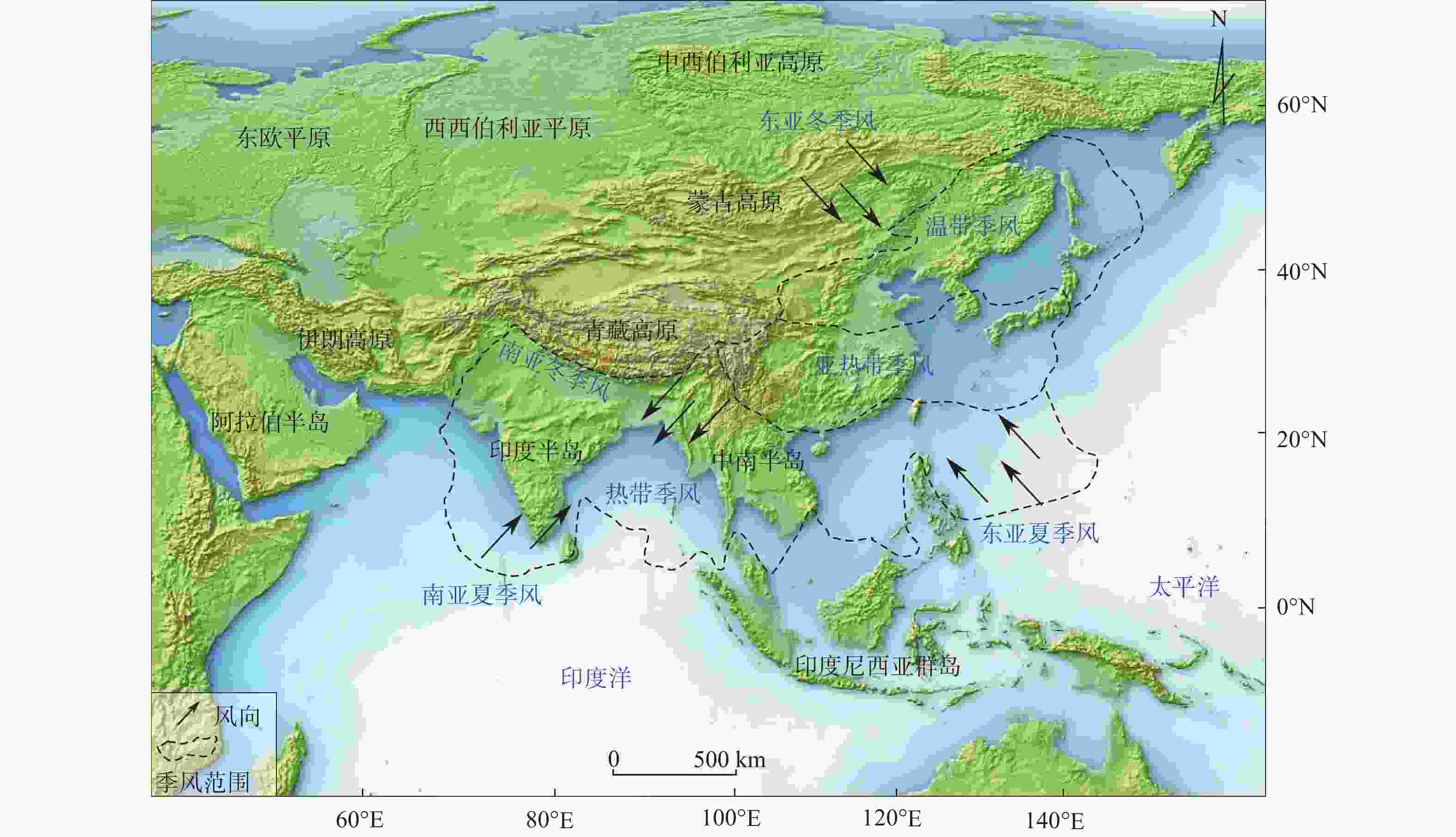
 下载:
下载:
